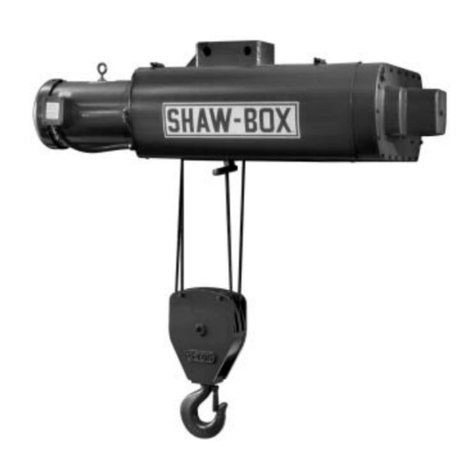
Page 7
and periodic inspection of the equipment may save injury to
personnel and damage to equipment.
a. Operate hoist cautiously to become familiar with its
performance.
b. Do not load hoist beyond rated load.
c. Take up chain slack carefully to avoid jerking load.
d. Never use hoist load chain as a sling.
e. Always be sure there is no twist in coil load chain. On 3/4
and 1 ton hoists, check to see that lower block is not
capsized between strands of chain.
f. Check both upper and lower limit stop operation by raising
or lowering empty hook to limit of travel. Hoist must shut
off.
g. When lifting load, make certain it is free to move and will
clear all obstructions.
h. Stand clear of all loads and never lift or travel loads over
people.
j. Avoid operating hoist when hook is not centered under
hoist. Be sure that hoist trolley or other support mechanism
is correctly positioned for handling the load before lifting.
k. Guide load so as to have it under control at all times.
I. Do not operate hoist with twisted, kinked or damaged
chain.
m. Do not operate damaged or malfunctioning hoist.
n. Conduct periodic visual inspection for signs of damage
or wear.
o. Observe inspection and maintenance procedures
described in this manual.
p. Never lift or transport a load until all personnel are clear.
Never lift people on hook or load.
q. Do not divert attention from load while operating hoist.
Never leave a suspended load unattended.
r. Do not use limit stop as normal operating stop. This is a
safety device only.
s. Do not “jog” unnecessarily.
t. Personnel not physically fit or properly qualified, shall
not operate hoist.
u. Do not remove or obscure warning labels.
v. Use common sense and best judgement whenever
operating a hoist. Observe American National Standard
Safety Standard, ANSI B30.16 latest issue.
SECTION IV - LUBRICATION
4-1. GENERAL. The lubrication services outlined in paragraphs
4-2 through 4-7 should be performed at regular intervals to
maintain top hoist performance and insure long life. Frequency
of lubrications will depend on type of hoisting service hoist is
subjected to and should coincide with preventive maintenance
inspections. See Section V - Maintenance.
4-2. SERVICE AIR LINE LUBRICATOR. Servicing air line filter
and lubricator unit is of primary importance since it is the only
source of lubrication for control valves and air motor. Fill
lubricator with Air Hoist Motor Oil or good grade 10W machine
oil (approximate viscosity 150 SSU at 100°F.). Multi-viscosity,
detergent type engine oil is not recommended.
4-3. GEARCASE. The gearcase is grease packed at the factory
and requires no further greasing unless the gearcase is for
any reason disassembled. Then, at reassembly, the parts
should be washed clean (using commercial fluid) and
repacked with NLGI EP-2 Grease.
4-4. LUBRICATE LOAD CHAIN. A small amount of lubricant
will greatly increase load chain life; therefore, chain should
not be allowed to run dry. Chain should be cleaned and
lubricated as directed in paragraphs a. and b. below,
depending upon type of chain. User should set up a regular
schedule for chain lubrication after observing operating
conditions for a few days. Use Bar and chain Oil (LUBRIPLATE
or equal) on load chain.
a. Coil Chain. Under ordinary conditions, only weekly attention
will be necessary for alloy steel chain. Under hot and dirty
conditions, it may be necessary to clean chain at least once a
day and lubricate it several times between cleanings.
Thoroughly clean chain with an oil solvent and relubricate by
coating it lightly with penetrating oil and graphite. Make sure
that lubricant coats wear surfaces between links.
Stainless steel load chain must be well lubricated at all times
and must be inspected daily when in use.
b. Roller Chain. Under ordinary conditions, only monthly
attention will be necessary. Under hot and dirty conditions,
weekly attention may be required. Thoroughly clean chain with
an oil solvent and apply a good grade of S.A.E. 20 motor oil.
Wipe off excess oil. When subjected to excessive moisture or
corrosive atmospheres, DO (dripless oil) lubricant from
American Grease Stick Company is recommended for use on
roller chain in place of regular motor oil.
4-5. LUBRICATE UPPER HOOK AND LOWER BLOCK
ASSEMBLY.
a. On 3/4 and 1 ton hoists, apply a few drops of S.A.E. 60 oil
on shank of upper hook where it enters suspension bracket.
b. On single line hoists (1/4, 3/8 and 1/2 ton) disassemble
upper and lower hooks as described in 7-2.b.(4) and grease
thrust bearings with a good grade of bearing grease.
c. On double line hoists (3/4 and 1 ton) lower blocks,
disassemble as described in 7-2.b.(5) and grease needle
bearings for sprocket shaft and hook with a good grade of
bearing grease.
4-6. LUBRICATE CONTROL SHAFT, BRAKE CAM AND
VALVE SHIFTER.
a. Apply a few drops of S.A.E. 60 oil on control shaft at bearing
points.
b. Apply graphite grease on valve shifter and on brake cam.
4-7. LUBRICATE TROLLEY WHEEL BEARINGS. If hoist is
mounted on a trolley, apply light grease to wheel bearings as
recommended by trolley literature.
Before performing any internal work on hoist, remove
load and be certain air is shut off.
WARNING
SECTION V - MAINTENANCE
5-1. GENERAL. Preventive maintenance services required on




























